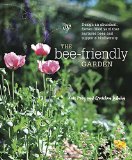 We often hear about the sad plight of honeybees and the need for doing something abut it. The Bee-Friendly Garden by Kate Frey and Gretchen LeBuhn is a great source of information on addressing the problem of the honeybees and a lot more. Frey is garden designer while LeBuhn is a bee expert and together they have produced a book that gives the reader a wealth of information on many different kinds of bees and the gardens that will best support them.
We often hear about the sad plight of honeybees and the need for doing something abut it. The Bee-Friendly Garden by Kate Frey and Gretchen LeBuhn is a great source of information on addressing the problem of the honeybees and a lot more. Frey is garden designer while LeBuhn is a bee expert and together they have produced a book that gives the reader a wealth of information on many different kinds of bees and the gardens that will best support them.
After an introduction on the importance of bee friendly gardens, the book turns to consider the bees themselves and the gardens that allow them to thrive. The first chapter is devoted to the bees themselves, both honeybees and native bees such as bumble bees, masked bees, and sweat bees. The characteristics of the different kinds of bees are described, myths about bees are explored, and the specific needs of bees such as nesting sites, food, and water, are discussed. Here is where the reader learns about nectar guides, that flowers in the daisy family are especially loved by bees, and that bees are most attracted to blue, yellow, and white flowers.
Chapter 2 considers the kinds of bee plants that are both attractive and easy to grow. Annuals, perennials, shrubs, and trees are included and brief plant lists of the best ones in each group are included. One of the outstanding features of this chapter are the plant combinations suggested by Frey, like purple spider flower (Cleome), Mexican sunflower (Tithonia rotundifolia), and orange Klondike cosmos (Cosmos suphureus). Wow! Another great feature of this chapter is the discussion of superbloomers, plants that bloom six months or more. Further discussions consider plants that support other beneficial insects and hummingbirds, plants that are injurious to bees, and factors that influence bloom, nectar, and pollen.
In chapter 3, the authors turn to edible gardens and suggest bee friendly herbs and flowers to include in them. Chapter 4 considers the basic bee gardening techniques such choosing the plant material to meet the needs of various bees at different times of the year, and providing nesting sites and water. Garden design is covered in chapter 5 with suggestions for bee-friendly garden layouts and plants. Ideas are included for many different garden styles from a minimalist garden or medium strip, to a cottage garden and formal garden. As the authors discuss gardens in various climates they emphasize the principal of “right plant for the right place.” The final chapter describes what concerned individual can do to help improve the plight of bees.
An appendix on resources gives a list of bee-friendly nurseries by geographic region, bee-friendly public gardens, recommended books, pollinator organizations, and website on the topic. A second appendix is an extensive plant list by region giving the common name, Latin name, and hardiness zone for each plant, and indicating which plants are native, invasive, or spreading.
To buy name of book Click Here.